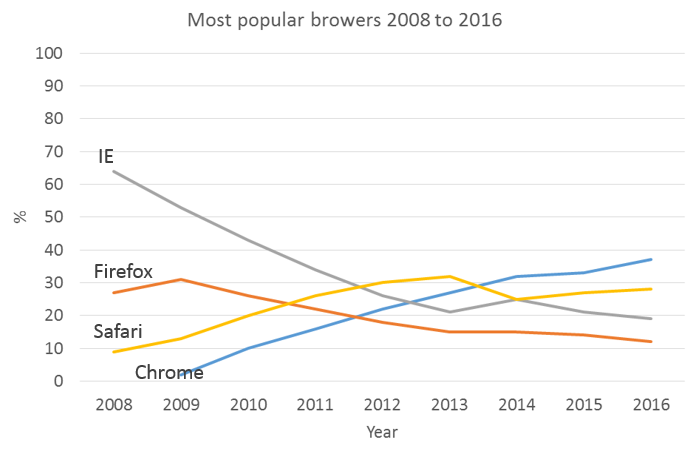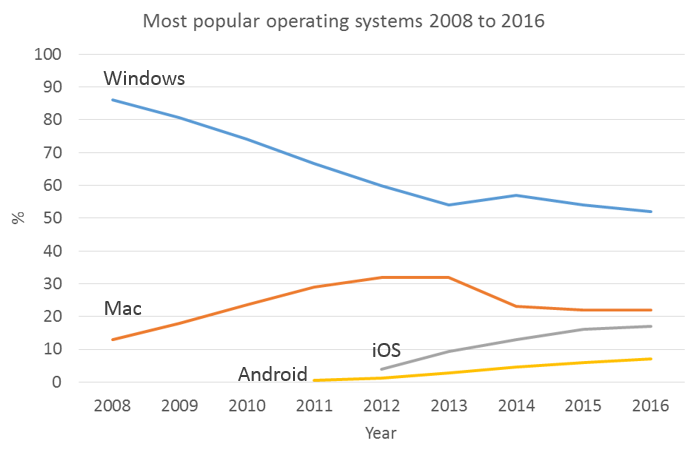Which technology is being used to access the University website?
Understanding which technology is being used to access the University website is very important as we need to ensure an optimum experience for as many users as possible.
Browsers 2008 to 2016
The browsers used to access the University website over the past nine years has changed dramatically. The most popular browsers used between April and September 2016 (total of 4,113,245 sessions) were:
- Chrome – 37%
- Safari – 28%
- Internet Explorer – 17%
- Firefox – 12%
- Edge – 2%
Chrome is now the most popular browser, while Internet Explorer and Firefox have steadily declined between 2008 and 2016.
Microsoft Edge comes with Windows 10 and is the the replacement for Internet Explorer. It will be interesting to see how this browser appeals to users in the future.
 Internet Explorer
Internet Explorer
Internet Explorer (IE) is notorious for presenting headaches to web developers as each version affects the way webpages are rendered. While IE 11 is the most popular, there are still a large number of users using IE 7. This means that they will not be getting the optimum view of the University website as we don’t support this version of IE.
The most popular versions of Internet Explorer between April and September 2016 (total of 702,833 sessions) were:
- IE 11 – 73%
- IE 7 – 22%
- IE 9 – 2%
- IE 10 – 1.5%
- IE 8 – 1.1%
- IE 6 – 0.02%
It is interesting to see that there are still a few people using IE 6 and indeed one person using IE 5!
Operating systems 2008 to 2016
Browsers require operating systems to run. The decline of Windows and Macintosh over the past few years has been due to the rise in mobile technology. In the past six months, 23% of users used a mobile device to access the University website.
The most popular operating systems used between April and September 2016 (total of 4,113,245 sessions) were:
- Windows – 52%
- Macintosh – 22%
- iOS – 17%
- Android – 7%
Microsoft Windows
Microsoft Windows has a long and chequered history with big changes in the user interface from one version to another. Over the past six months, the most popular versions of Windows (total of 2,118,250 sessions) were:
- Windows 7 – 63%
- Windows 10 – 25%
- Windows 8.1 – 8.5%
- Windows XP – 1.4%
- Windows 8 – 1.1%
- Windows Vista – 0.8%
- Windows Server 2003 – 0.02
At the University, the majority of PCs are using Windows 7 – this is the current version used on the PC classrooms. This supports browsers up to IE 11.
Interestingly, on Windows 10, the most popular browser is Chrome, indicating that Edge, which ships with Windows 10 is not very popular.
XP, Vista and Server 2003 are no longer supported by Microsoft. Users of these systems are vulnerable to security attacks.
Conclusion
Analysis of our visitors has revealed some useful insights. There are still a number of users using the IE 7 and Windows XP. These users will not be getting a good user experience on the University website!
The rise in mobile technology and associated browsers is dramatic and will continue to rise. Fortunately the roll-out of responsive websites that will work on a variety of platforms is something we are actively working on.
